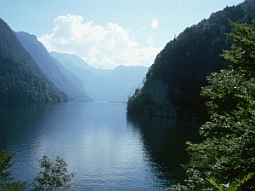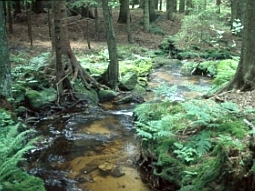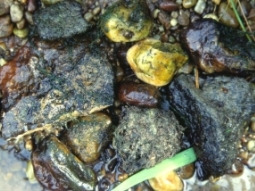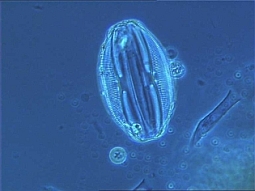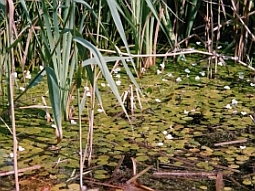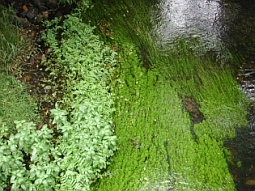Motives and Aims
Assessing the ecological status, biological assessment methods are used which are reference-based. That is, that the biocoenosis (community of organisms in a habitat) of every evaluated waterbody has to be compared with the biocoenosis of the reference status of this waterbody type. Unloaded or least disturbed waterbodies (reference sites), literature studies and expert knowledge are sources to derive references. Since different types of waterbodies have naturally different biocoenosis and biomass, all investigated waterbodies are related to their waterbody type. Each waterbody type has an own reference status. Because the classification of a waterbody type has a great impact of the assessment, it should be checked critically.
To assess a waterbody, the taxonomic composition and abundance of following four groups of organisms are used:
- Phytoplankton: micro-algae and diatoms, floating in the water e.g. as an indicator for the nutrient content in the surface water
- Macrophytes & Phytobenthos: aquatic plants and periphyton algae e.g. as an indicator for the nutrient content of water and bankside sediment
- Makrozoobenthos: invertebrates living on the ground of waterbodies, like larvae, worms, crustacean, slugs, mussels. e.g. as an indicator for the structure of bankside habitats
- Fishes: e.g. as an indicator for the hydro-morphology and pollution of the waterbody
The component of benthic flora "macrophytes & phytobenthos" includes higher aquatic plants, algae, mosses, and water ferns (summarized as macrophytes), along with periphyton algae inclusive diatoms (summarized as phytobenthos).
For the assessment of a waterbody, its macrophyte and phytobenthos community has to be compared to the reference of the same type of waterbody: The more reference species (and the less degradation species) found in a study site, the merrier is its ecological status. Moreover, the more the species composition of the two societies deviates, the more distinct is the degradation of the examined waters section – and the worse the class of the ecological status.
For this analysis step the Bavarian Environmental Agency (LfU) was assigned to generate a national method for lakes and rivers (term of the project 1999-2004). Followed by several project steps, this procedure run national tests of practice and adaptions (see publications), as well as in a legally required process it was intercalibrated in an European comparison with the EU-neighbored states of Germany.
Connected with the assessment procedure PHYLIB a software is available, that enables all users to evaluate the ecological status.
From time to time and on behalf of the Bund-Länderarbeitsgemeinschaft Wasser (LAWA) new requirements make updates necessary concerning the assessment method, guidance instructions and field protocols as well as the calculation software. This is to adapt to the current status of science and expert knowledge generated by the German federal states.
Brief Description
With the procedure PHYLIB the ecological status of rivers and lakes is assessed with the component macrophytes and phytobenthos for implementation of the WFD. In rivers the appearance and abundance of organisms of macrophytes and phytobenthos is mapped and samples are taken, respectively, at a type specific section of 100 m length. Lakeshore are split into sections for investigation. The investigation of macrophytes and simultaneous sampling of phytobenthos in rivers and lakes should occur during main growing season (beginning of July to mid-August). The software PHYLIB includes registers of indicator taxa. Hereby the category of the status is determined for every section of the lake for the composition of species (species as references and degradation) of macrophytes and diatoms. With the arithmetic mean the ecological class of status is calculated for the total waterbody according to WFD with the biological component macrophytes and phytobenthos. In rivers the sampled section is assessed.
Contact
- Dr. Jochen Schaumburg, Bavarian Environmental Agency (LfU), Unit Ecology of Lakes
- Christine Schranz, LfU, Unit Ecology of Lakes
Developing this assessment procedure following persons have contributed
- Dr. Jochen Schaumburg (LfU), project management, intercalibration since July 2001
- Christine Schranz (LfU), project coordination, Diatoms since August 2002
- Dr. Ursula Schmedtje (LfU), project management until June 2001
- Barbara Köpf (LfU), project coordination until July 2002
- Dr. Susanne Schneider (TUM), Macrophytes
- Dr. Doris Stelzer (TUM, freelance), Macrophytes, Intercalibration
- Dr. Petra Meilinger (TUM), Macrophytes
- Dr. Antje Gutowski (Uni Bremen, freelance), Phytobenthos without Diatoms
- Dr. Julia Foerster (Uni Bremen, freelance), Phytobenthos without Diatoms
- Dr. Peter Pfister (freelance), Phytobenthos incl. Diatoms
- Dr. Gabriele Hofmann (freelance), Diatoms
- Dr. Andrea Vogel (freelance), Diatoms
- Dr. Ullrich Welzl (??), statistics
Instruction Protocols
For download, here are available the instruction- and field-protocols for the ecological assessment for macrophytes and phytobenthos in rivers and lakes for the implementation of the WFD. All documents will be updated frequently. Thereby it is adapted to the latest state of development of this procedure.
Further Informations
Links to other Websides
Documents for Download
- Instruction Manual for the Assessment of Running Waters - updated Jan 2012- PDF
- Field Protocol Phytobenthos in Running Waters - PDF
- Microscopy Protocol Phytobenthos (PoD) in Running Waters single subreport - PDF
- Microscopy Protocol Phytobenthos (PoD) in Running Waters collected subreports - PDF
- Field Protocol Diatom in Running Waters - PDF
- Field Protocol Macrophytes & Phytobenthos in Running Waters - PDF
- Instruction Protocol for Lakes - February 2014 - PDF
- Field Protocol Macrophytes and Phytobenthos in Lakes - PDF
- Field Protocol Sampling in Reservoirs - PDF


